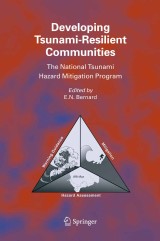Details

Developing Tsunami-Resilient Communities
The National Tsunami Hazard Mitigation Program|
96,29 € |
|
| Verlag: | Springer |
| Format: | |
| Veröffentl.: | 11.08.2005 |
| ISBN/EAN: | 9781402036071 |
| Sprache: | englisch |
| Anzahl Seiten: | 186 |
Dieses eBook enthält ein Wasserzeichen.
Beschreibungen
As the world grieves over the catastrophic loss of humanity from the 26 December 2004 tsunami, we must resolve to learn from nature’s lessons. This issue provides a framework and a set of tools to develop communities that are resilient to tsunami. This collection of papers represents a starting point on our new journey toward a safer world. The history of tsunami hazard mitigation tracks well with the history of destructive tsunamis in the United States. Following the 1946 Alaska g- erated tsunami that killed 173 people in Hawaii, the Paci?c Tsunami Warning Center was established in Hawaii by a predecessor agency to the National Oceanic and Atmospheric Administration (NOAA). Following the 1960 Chilean tsunami that killed 1,000 people in Chile, 61 in Hawaii, and 199 in Japan, the United States formed the Joint Tsunami Research E?ort (JTRE) and sta?ed the International Tsunami Information Center (ITIC) in Hawaii. JTRE was formed to conduct research on tsunamis while ITIC, sponsored by the United Nations, was formed to coordinate tsunami warning e?orts of the Paci?c Countries. Many research and mitigation e?orts were focused on the distant tsunami problem. Following the 1964 Alaskan t- nami that killed 117 in Alaska, 11 in California, and 4 in Oregon, the U. S. was confronted with the local tsunami problem. In response, the U. S. established the Alaska Tsunami Warning Center in Palmer, Alaska. In 1992, a Ms 7.
The U.S. National Tsunami Hazard Mitigation Program: A Successful State—Federal Partnership.- The NTHMP Tsunameter Network.- Real-Time Tsunami Forecasting: Challenges and Solutions.- The Seismic Project of the National Tsunami Hazard Mitigation Program.- Impact of the National Tsunami Hazard Mitigation Program on Operations of the Richard H. Hagemeyer Pacific Tsunami Warning Center.- Progress in NTHMP Hazard Assessment.- Local Tsunami Warning in the Pacific Coastal United States.- Planning for Tsunami-Resilient Communities.- The Role of Education in the National Tsunami Hazard Mitigation Program.- Planning for Tsunami: Reducing Future Losses Through Mitigation.- NOAA Weather Radio (NWR) — A Coastal Solution to Tsunami Alert and Notification.- Measuring Tsunami Preparedness in Coastal Washington, United States.
<P>Eddie Bernard has served as Director of the National Oceanic and Atmospheric Administration’s Pacific Marine Environmental Laboratory (PMEL) since 1982, where he leads a staff of 175 scientists, engineers, and technical support specialists in oceanographic research related to El Ninos, fisheries/ climate interactions, impact of underwater volcanoes on the oceans, and tsunami. Since receiving his Ph.D. in physical oceanography in 1976, he has published over 70 scientific/technical articles on tsunamis and other oceanographic topics. During his 34 year career in NOAA, he has also sailed on oceanographic research vessels and directed the Pacific Tsunami Warning Center. In 1997 he was elected the first Chair of the National Tsunami Hazard Mitigation Program- a five state, three agency partnership to reduce the impact of tsunamis on US coastlines. In 2002 he received the prestigious Presidential Rank Award from President Bush for his exceptional service to the public.</P>
<P>Tsunamis remain an ever-present threat to lives and property along the coasts of most of the world’s oceans. Because of the geographical extent of U.S. coastlines, an earthquake in Alaska can generate a local tsunami for Alaskans and, hours later, a distant tsunami for communities in Hawaii and along the Pacific Coast . This volume chronicles the development and accomplishments of a joint State/Federal partnership that was forged to reduce tsunami hazards along U.S. coastlines – the National Tsunami Hazard Mitigation Program. By integrating hazard assessment, warning guidance, and mitigation activities, the program has created a roadmap and a set of tools to develop communities more resilient to local and distant tsunamis. Among the set of tools are tsunami forecasting, educational experiments, early alerting systems, and design guidance for tsunami-resilient communities. Part of this book has already been published in a recent journal issue.</P>
Focuses on the accomplishments of a single program in the US to reduce the impacts of tsunamis to threatened communities

















